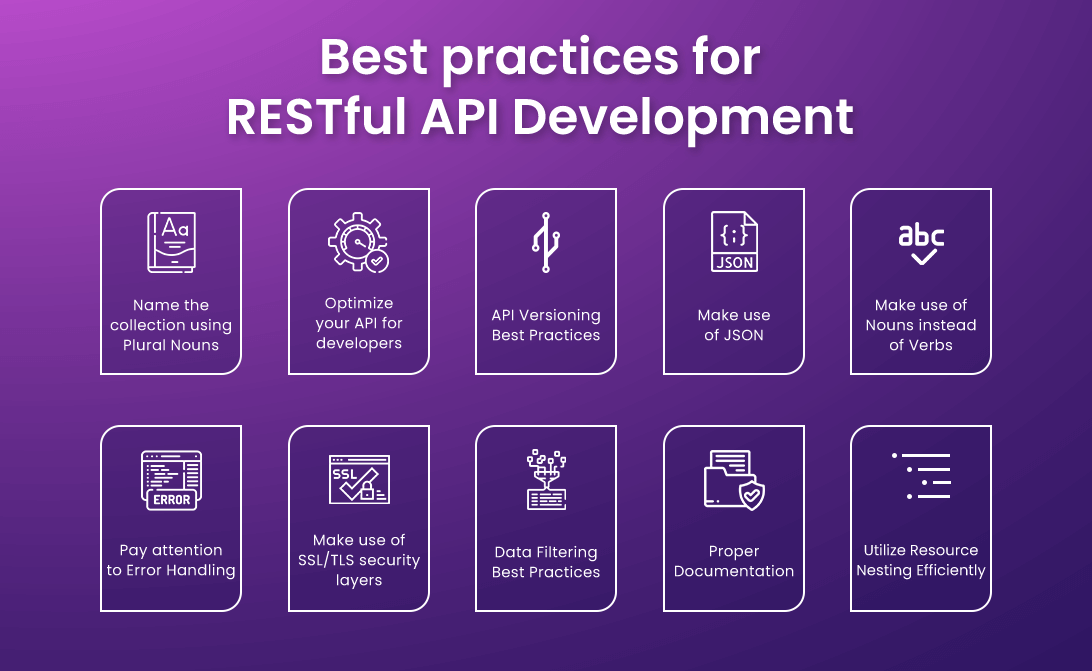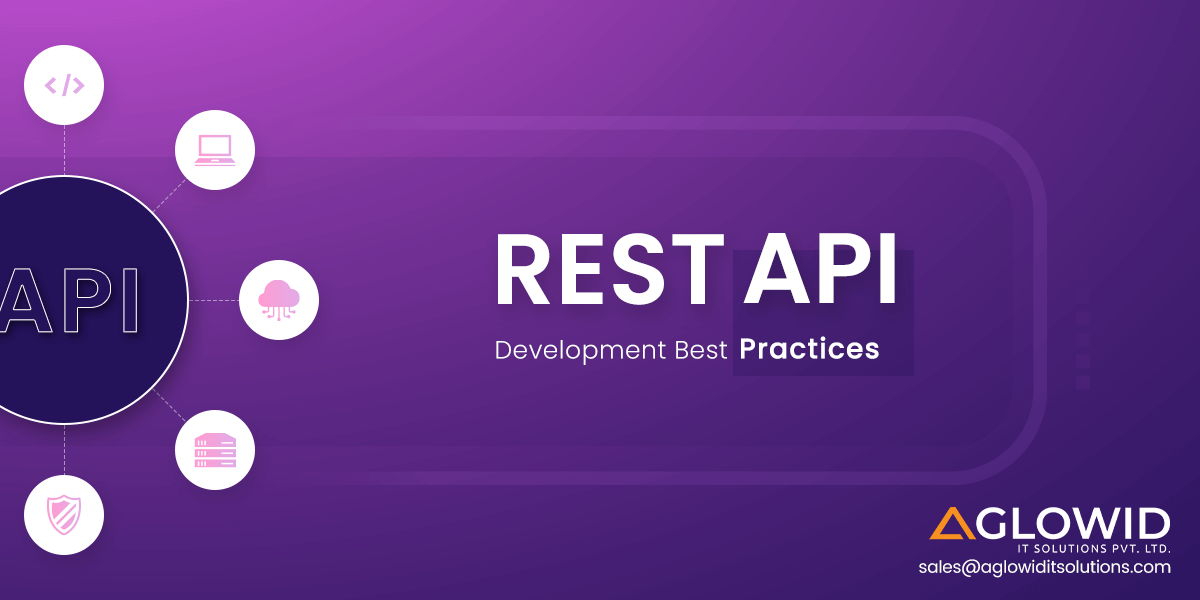Quick Note: APIs have become a rapidly growing field where every software you use today will involve API to some extent. API-related jobs are also rising to new heights every year. With each passing year, the security concerns around poorly written web APIs are also on the rise, which is why there is a need to know and practice some of the REST API design best practices to prevent such instances.
An API dictates a set of rules that define how devices or applications can connect and communicate with each other. Big tech companies like Netflix, GitHub, and Facebook are the frontrunners of this show as they are welcoming developers with extended arms to exploit their data by using APIs. However, well-planned and strategically placed REST APIs are the secret behind elevating many tech platforms today.
APIs help developers communicate with the data. Therefore, effective APIs can bring ease and comfort to any developer’s life. However, if the REST APIs are not designed perfectly, there can be many fatal consequences that add to the challenges of the developers instead of improvising the user experience. Hence, following the REST API best practices is a must to serve your clients with the most efficiency.
Key Characteristics of RESTful APIs
Before understanding the best practices for API design, we should first understand what an efficient RESTful API consists of. Here is a quick REST API checklist for you to test your APIs against.

1.It should be easily readable
Any well-designed API is going to be easy to work with. Developers can easily memorize its associated operations and resources after repetitively using them.
2.Difficult to misuse
If you implement and integrate your API with a clean and crisp design, the chances of writing incorrect code will reduce insignificantly. Moreover, it provides useful feedback without imposing strict guidelines on the end consumer.
3.Complete & Concise
A complete API makes it possible for developers to make promising apps against the risk of data you expose. As a result, most API developers don’t rush to finish the entire project simultaneously but instead build on their existing APIs.
Best practices for RESTful API Development
- Name the collection using Plural Nouns
- Optimize your API for developers
- API Versioning Best Practices
- Make use of JSON
- Make use of Nouns instead of Verbs
- Pay attention to Error Handling
- Make use of SSL/TLS security layers
- Data Filtering Best Practices
- Proper Documentation
- Utilize Resource Nesting Efficiently
Now that we know the importance of REST API development and the key characteristics of the same, we should focus on designing REST API best practices. Follow these tips and tricks to develop and design your ideal website with great performance capabilities.

1. Name the collection using Plural Nouns
As a generally accepted norm, REST API developers use plural nouns for collections. It is one of the REST services best practices that makes it easier for consistency in global code sharing and for normal people to understand that those clubbed APIs are a collection. For instance –

- GET/bikes/123
- POST/bikes
- GET/bikes

- GET/bike/123
- POST/bike
- GET/bike
2. Optimize your API for developers
One of the best API design best practices is to implement APIs so that they are easy to understand and use. There are some best practices of API design that can help improve the overall readability and efficiency of your APIs –
- Always use nouns in place of verbs in HTTP methods.
- Follow the accepted norms of using plural nouns for collections to avoid confusion.
- Explain error handling in simple and straightforward terms.
- Name systems with a simple and clear naming system.
3. API Versioning Best Practices
Versioning is one of the REST API best development practices as it allows developers to introduce any changes in the data structure or specific actions. As your project increases in size and passing the time, you might manage more than only one API version. But, on the upside, this will allow you to introduce more modifications and improvements in your service while holding a part of your API users that are reluctant to change or slow in adapting to the new changes.
There are two ways you can go about versioning –
1. Implement version in the header
You can customize the accept media type header for specifying the version –
Accept: application/vnd.myapi.v2+json
or
Accept: Application/vnd.api.article+xml; version=1.0
Pros and Cons
- Directly version at the resource level
- Preserve URLs between versions
- Closest solution to the original RESTful specification.
- Managing resources and API both using this technique can be complex.
2. Implement version in the endpoint URL
In this method, you will use different URL paths for different versions of API endpoints. It would look like –
api.example.com/v1/resource
Pros and Cons
- Most common API method
- Ability to explore different versions via browsers
- Goes against RESTful compliance.
4. Make use of JSON
JSON (JavaScript Object Notation) is the easiest programming language and format to read and use. However, still not all APIs make use of JSON. It is considered as one of the REST API development best practices. Many developers are replacing or substituting their existing SOAP (Simple Object Access Protocol) in favor of REST.
Key Features of JSON –
- Easy to parse
- Support for most frameworks
- Can be used by any programming language
5. Make use of Nouns instead of Verbs
REST API development is also called resource-based API prototype. Hence, when you work on your applications, you work with their resources and collections. The actions on resources are strictly defined by utilizing HTTP methods like GET, PUT, POST, PATCH, and DELETE. Therefore, you should only use these tags for changing the state of the resource. This results in endpoint URL construction.
Understand REST API Verbs here
| REST Verb | Action | Success | Failure |
| GET | Fetches a record or set of resources from the server | 200 | 404 |
| OPTIONS | Fetches all available REST operations | 200 | – |
| POST | Creates a new set of resources or a resource | 201 | 404, 409 |
| PUT | Updates or replaces the given record | 200, 204 | 404 |
| PATCH | Modifies the given record | 200, 204 | 404 |
| DELETE | Deletes the given resource | 200 | 404 |
This is how your constructed endpoint should look like: GET/books/123
DELETE/ books/123
POST/books
PUT/books/123
PATCH/book/123
6. Pay attention to Error Handling
No matter how great of a developer you are, every project is always prone to errors. Hence, error handling is an important skillset in API development. An effective API will always return the proper HTTP error code, which correctly would define the nature of the individual error that occurred. The sooner the problem gets detected, the cheaper and easier it is to fix. There are 71 distinct HTTP status codes with clear error messages. Generally, standard error handling of HTTP statuses is enough but adding a verbose message with internal code reference is always better and more accessible for the user to understand.
An ideal error handling code should consist of –
- Error – a unique identifier of the error
- Message – a comprehensive, readable message
- Detail – lengthier explanation of the message
For instance, if a client sends a request to log in with incorrect credentials, we can send a 401 response with this code –
{ "error": "auth-0001", "message": "Incorrect username and password", "detail": "Ensure that the username and password included in the request are correct" }
7. Make use of SSL/TLS security layers
One of the REST API development best practices is using SSL/TLS for encrypting the communication with your API. Database security is one of the most pressing concerns for any API developer. A security breach can cost millions of dollars in losses. Furthermore, users trust these companies with their sensitive data like credit card details. Hence, we need to keep this communication between the client and server extremely private.
Using an SSL (Secure Socket Layer) and TLS (Transport Layer Security) helps generate a secure connection by providing the user with a public and a private key. This encrypts the connection effectively. TLS is an advanced version of SSL with more protection and security. You can tell a website uses TLS security by the mention of HTTPS in its URL.
8. Data Filtering REST API Best Practices
Huge databases can become challenging to manage. One of the most difficult aspects of ensuring a secure connection with API is retrieving only the data that has been requested without exposing the entire database. To do this, you need to use a filter that would only return the data that fulfills the request. This saves huge bandwidth size on the client-side. As your database grows, the importance of data filters become more and more important. REST API offers different types of filtering options like –
- Filtering
- Sorting
- Paging
- Field Selection
Filtering, sorting, paging, and field selection are important features for efficiently using REST API. Most of these resource collections are often overwhelmingly vast, and retrieving specific data from this big list can be like finding a needle in a haystack. So instead of going through the entire exhaustive list of resources, we can make use of –
1. Filtering
It helps narrow down results using specific search parameters like – creation date, country, and more.
ET /users?country=UK GET /users?creation_date=2021-10-11 GET /users?creation_date=2021-10-11
2. Sorting
Allows you to sort the results ascending or descending format by your preferred parameter or parameters like dates.
GET /users?sort=birthdate_date:asc GET /users?sort=birthdate_date:desc
3. Paging
Makes use of ‘limit’ for narrowing down the number of results to be a specific number. It also uses ‘offset’ to inform which part of the overall results is displayed.
GET /users?limit=120 GET /users?offset=3
4. Field Selection
Field selection is a convenient REST API development function that allows developers to request only a specific part of the available data for a particular object. Hence, if the thing you are querying about has too many fields and you need only a few specific ones, you can use field selection to specify the ones you want to include in the response.
An object can have the following fields –
- Name
- Surname
- Birthdate
- Phone
For instance, we want the name and birthdate and email id for creating a list of birthdays for automating birthday wishes. This query would look like this –
For one specific user
GET/ users/123?fields=name,birthdate,email
For the full list of users
GET/ users?fields=name,birthdate,email
9. Proper Documentation
When it comes to utilizing any framework, application, or software, proper documentation is necessary to understand the respective solution and as a constant reference source for troubleshooting when needed. Proper API documentation needs to be concise and simple to understand for any non-technical person as well.
Having complete documentation will help you help your users understand essential aspects like security, authentication, and error handling. Make use of interactive tutorials, guides, and easily accessible resources. The more organized your documentation will be, the easier utilizing your API for your users will be.
10. Utilize Resource Nesting Efficiently
Resource nesting is a useful practice to club two functions that share some hierarchy or are interlinked to each other. For instance, in an online store, ‘users’ and ‘orders’ are resources under the same category. A user is on an online store to ‘order’ something and the ‘order’ belongs to the ‘user.’ Let us see how this would look in code –
/users // list all users /users/123 // specific user /users/123/orders //list of orders that belong to a specific user /users/123/orders/0001 // specific orders of a specific users order list
Nesting is an efficient practice for the logical grouping of resources. However, most developers overuse it, which makes it lose its appeal. It also creates complicated dependencies that can be difficult to understand by a typical user or even some developers. Hence, keeping your resource nesting limited to one level is one of the REST API best practices.
“Build Enterprise-Grade REST APIs”
That are Secure, Easy to Consume, Well Documented & Truly Reliable
Wrapping it up!
These are the API development best practices for RESTful APIs. Use this REST API developer guide to improve your API performance, accuracy, and reliability, which will help you help your end consumer better. There is no definitive approach to API development that works as a one-fits-all solution. You should base your API development best practices based on your requirements.





 Say
Say